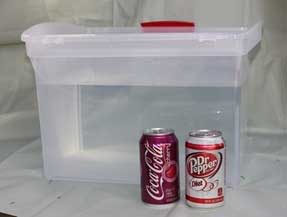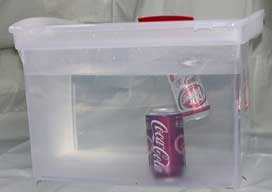Physics in the kitchen: Sink or Swim Soda
If you ever find yourself floating in the sea with only a can of diet soda and a can of regular soda, which one could be a floatation device.
What you Need

- One can of diet soda
- One can of regular soda
- A bathtub, sink or tub of water
What to Do
- Fill the bathtub, sink or container with water.
- Put the cans of soda (regular and diet) in the bathtub, sink or container that you filled with water.

- Observe. Which one floats? Which one sinks?
What's Going On?
Inside each can of soda there are almost the same basic ingredients: carbonated water and a sweetener of some sort. In diet soda that sweetener is usually made from aspartame and in regular soda the sweetener is made of sugar in the form of high fructose corn syrup. Aspartame and other sugar substitutes have a much smaller mass than sugar or high fructose corn syrup. Mass is the measure of how much stuff is inside something. If you want to feel this difference, next time you are out to eat, pick up a packet of sugar and pick up a packet of the sugar substitute on the table (Sweet-n-low, Equal, Truvia, Splenda, etc. are all sugar substitutes). Which one feels heavier? I bet the sugar packet was noticeably heavier. It felt heavier because it has more mass or more stuff in it. This brings us to the next part of our explanation. Sugar, being that it has more mass than sugar substitute also means that it is denser than sugar substitute. Density is the amount of mass in a given volume or, in other words, how much stuff is in a given size. Basically, if you have the same size pile of sugar and the same size pile of sugar substitute, the sugar will have more mass than the pile of sugar substitute. Objects with a higher density than the substance it is submerged in will sink. Objects with a lesser density than the substance it is submerged in will float. Sugar substitute is less dense than water and sugar or high fructose corn syrup is denser than water. This explains why the can of diet soda, containing the less dense sugar substitute, floats and why the can of regular soda, containing the more dense sugar or high fructose corn syrup, sinks.











